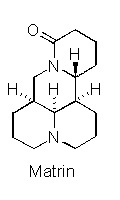Bohlmann-Bande?
Hallo! Mein Name ist Rolf
Bohlmann.
Kennen Sie Bohlmann-Banden? Nein? Im
folgenden finden Sie eine kurze Erklaerung dieses chemischen Fachbegriffs aus
der IR-Spektroskopie, der nach meinem Vater Ferdinand
Bohlmann benannt ist, weil er als erster diese Banden in der chemischen
Fachliteratur[1] beschrieben hat. Man
beobachtet die Bohlmann-Banden im IR-Spektrum der trans-Chinolizidin-Derivate
wie z.B. von Matrin (Bild 1) im Bereich zwischen 2500 - 2830 [1/cm]. Sie
stellen ein wertvolles Hilfsmittel zur Aufklaerung des raeumlichen Aufbaus
dieser Alkaloide dar. Nachdem es heute viele neue, leistungsfaehige Methoden in
der Spektroskopie gibt, ist die praktische Bedeutung der Bohlmann-Banden stark
zurueckgegangen.
Hello!
My name is Rolf Bohlmann.
I
have dedicated this page to the term “Bohlmann Bande". The plural
“Bohlmann Banden" is the German equivalent to the term Bohlmann
bands coined in the Anglo-Saxon chemical literature for specific absorptions in
the infrared spectra of certain heterocycles. They appear in the range 2500 -
2830 [1/cm] indicating the presence of a trans quinolizidine alkaloids.
There is little interference with the absorptions of other functional groups in
this range. The practical meaning and utility of those bands was first
discovered and published by F. Bohlmann. The
theoretical explanation[2]
of his empirical observation came years later. The implications of a
generalized Bohlmann effect on the molecular mechanics representation of
structural behavior are described in a recent paper[3].
Today the role of infrared spectra is due to the development of many new and
powerful spectroscopic methods much smaller than it was then.

